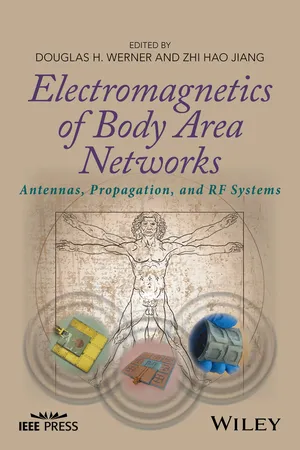
Electromagnetics of Body Area Networks
Antennas, Propagation, and RF Systems
- English
- ePUB (mobile friendly)
- Available on iOS & Android
Electromagnetics of Body Area Networks
Antennas, Propagation, and RF Systems
About This Book
The book is a comprehensive treatment of the field, covering fundamental theoretical principles and new technological advancements, state-of-the-art device design, and reviewing examples encompassing a wide range of related sub-areas. In particular, the first area focuses on the recent development of novel wearable and implantable antenna concepts and designs including metamaterial-based wearable antennas, microwave circuit integrated wearable filtering antennas, and textile and/or fabric material enabled wearable antennas. The second set of topics covers advanced wireless propagation and the associated statistical models for on-body, in-body, and off-body modes. Other sub-areas such as efficient numerical human body modeling techniques, artificial phantom synthesis and fabrication, as well as low-power RF integrated circuits and related sensor technology are also discussed. These topics have been carefully selected for their transformational impact on the next generation of body-area network systems and beyond.
Frequently asked questions
Information
1
Textile Antennas for Body Area Networks: Design Strategies and Evaluation Methods
1.1 Introduction
1.2 Textile Materials and Antenna Fabrication Procedure
1.2.1 Conductive Textiles/Foils
- Copper foil tape: a 0.035 mm thick foil, coated with a 0.03 mm thickness.
- ShieldIt Super [15]: a ripstop, woven polyester textile coated with copper and nickel. Its thickness is 0.17 mm and its estimated weight is 230 g/m2.
- Pure copper polyester taffeta fabric (PCPTF) [16]: plain woven and coated using pure copper. It has a thickness of 0.08 mm and an estimated weight of 80 g/m2.

1.2.2 Non-conductive Textiles
Table of contents
- Cover
- IEEE Press
- Title Page
- Copyright
- Dedication
- List of Contributors
- Preface
- Acknowledgments
- 1: Textile Antennas for Body Area Networks: Design Strategies and Evaluation Methods
- 2: Metamaterial-Enabled and Microwave Circuit Integrated Wearable Antennas for Off-Body Communications
- 3: AMC-Backed Flexible Near-Endfire Wearable Antennas for On-Body Communications
- 4: Novel Antenna Designs And Characterization Methodologies For Medical Diagnostics And Sensing
- 5: Basic Performance Characteristics of Wearable Antennas Over a Wide Frequency Range
- 6: Implanted Antennas and RF Transmission in Through-Body Communications
- 7: Antennas, Phantoms, And Body-Centric Propagation At Millimeter-Waves
- 8: Wearable Active Antenna Modules for Energy-Efficient Reliable Off-Body Communication Systems
- 9: More Than Wearable: Epidermal Antennas for Tracking and Sensing
- 10: Inkjet-Printed Smart Skins and Wirelessly-Powered Sensors for Wearable Applications
- 11: Circuits and Systems for Wireless Body Area Network
- 12: Ultra Low-Power MEMS-Based Radios for WBAN
- 13: Exploring Physiological Features From on-Body Radio Channels
- 14: Power/Data Telemetry Techniques for Implants or Wearable Systems
- Index
- EULA